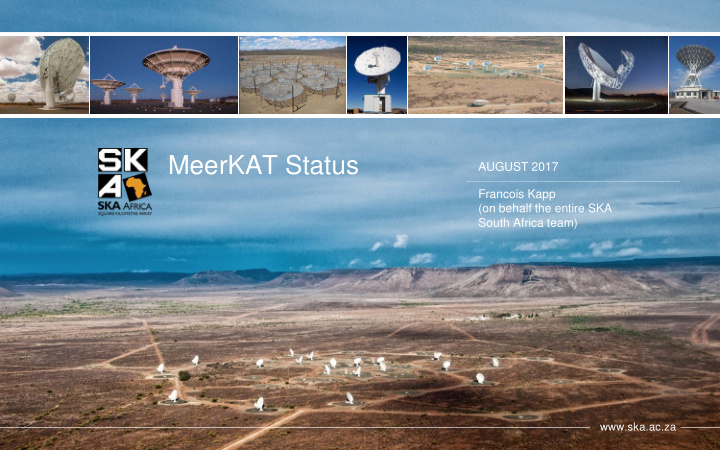



MeerKAT Status AUGUST 2017 Francois Kapp (on behalf the entire SKA South Africa team) www.ska.ac.za
MeerKAT www.ska.ac.za
MeerKAT construction - Dishes 64 x 13.5m highly efficient offset Gregorian dishes spread over 8 km (~75% within ~1km diameter)
MeerKAT construction – Feeds and Digitisers
MeerKAT construction – Time and Frequency Reference
MeerKAT construction – Correlator Beamformer
MeerKAT construction – Array Releases • Array releases: planned engineering milestones to enable early integration, test, verification and observations to support this • AR1 – June 2016 AR1.5 – March 2017 • • AR2 – late 2017 • AR3 – Q2 2018 • Followed by commissioning and then science use
MeerKAT construction Receivers: L-band receivers (0.9–1.67 GHz) UHF (0.58–1.0 GHz) S-band (1.75–3.5 GHz) X-band (8 – 14.5 GHz) planning stage
Extremely good L-band performance - Tsys Note: the resonant peak at 1420MHz is a measurement artifact that could not be calibrated out with sufficient accuracy
Extremely good L-band performance – Ae/Tsys
KAT-7 (engineering testbed) image in 2012 www.ska.ac.za
4-dish MeerKAT in May 2016 (commissioning) www.ska.ac.za
16-dish MeerKAT in June 2016 (Array Release 1) 1% of First Light image www.ska.ac.za
www.ska.ac.za
www.ska.ac.za
www.ska.ac.za
www.ska.ac.za
www.ska.ac.za
Technical challenges
MeerKAT Data Rates
MeerKAT SDP Hardware Landscape 23 PBytes 40 PBytes 1.6 PFLOPs (Disk - CEPH) (Tape) (GPU)
Array configuration in April 2017 ● 32 dishes available ( square surrounding core is 1.2 km on the side ) ● SKA SA commissioning team making a variety of observations to test telescope ● Closer commissioning interaction with LSP teams starting in May 2017 www.ska.ac.za
Commissioning in April 2017, up to 32 antennas www.ska.ac.za
Early 8 km-baseline observations “DEEP2 “ ● 4K channels ● 16 antennas dual-polarisation ● 12 hour track observed on 2017-04-04 ● Imaged with 2 x phase + 1 x amplitude self-calibration on 16 s timescale ● With Briggs - 0.5 weighting image has 9 μJy/beam (vs 10 μJy/beam in June 2016 image) ● Thermal is ~8.5 μJy/beam ● 1800 sources in central degree of field (vs 1400 in first light image) www.ska.ac.za
Array layout
FRII type galaxy – offset vs centred (Tom Mauch) www.ska.ac.za
HI emission in M83 (Spiral galaxy at 5 Mpc discovered in Cape Town in 1752 by Louis de La Caille) ● 32K channels (140 imaged) ● 16 core antennas, dual polarisation ● 9 hour track, 2017-04-05 ● Mosaic: 7 pointings ● ~50 minutes per pointing ● Min baseline (projected): 16 m ● Max baseline: 711 m ● Beam 90x70 arcsec ● Measured rms 2.8 mJy (emission-free chan) vs 2.3 theoretical www.ska.ac.za
M83 (Sean Passmoor) www.ska.ac.za
G330.89-0.36 star forming region (continuum, 32k mode) (Sharmila Goedhart) ATCA ● 8 channel binning ● No self-cal or primary beam corrections ● Imaged using wsclean: ● Multifrequency synthesis (7 channels) ● Multiscale (largest scale ~70 arcmin) ● Briggs robust 0 ● Beamsize 58x64 arcsec ● ATCA SGPS: 5 configs, 30 m – 3 km baselines ● Smoothed resolution 100 arcsec, sensitivity up to ~30 arcmin www.ska.ac.za
A newly identified Giant Radio Galaxy (Nadeem Oozeer) ● Hint of extended source in SUMSS ● 7-point MeerKAT mosaic in 4K mode ● Radio source (blue) angular size = 0.8 deg; elliptical galaxy (red /IR) at z = 0.02; linear size = 1.2 Mpc: GRG www.ska.ac.za
An extra (cool) detection in the new DEEP2 pointing (Spiral galaxy in continuum [and optical] at 70 Mpc) www.ska.ac.za
MeerKAT: What is next? ● AR2 within weeks ● AR3 within months (Q2 2018) ● Many hours of Commissioning ● Formal operations ● Eventually: Integration with SKA1… www.ska.ac.za
SKA South Africa, a Business Unit of the National Research Foundation, is supervising South Africa’s involvement in the SKA on behalf of the Department of Science & Technology. Thanks
Recommend
More recommend